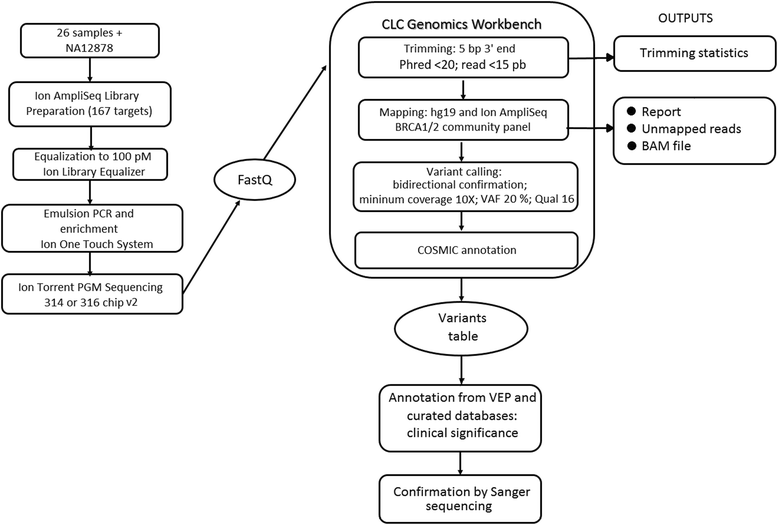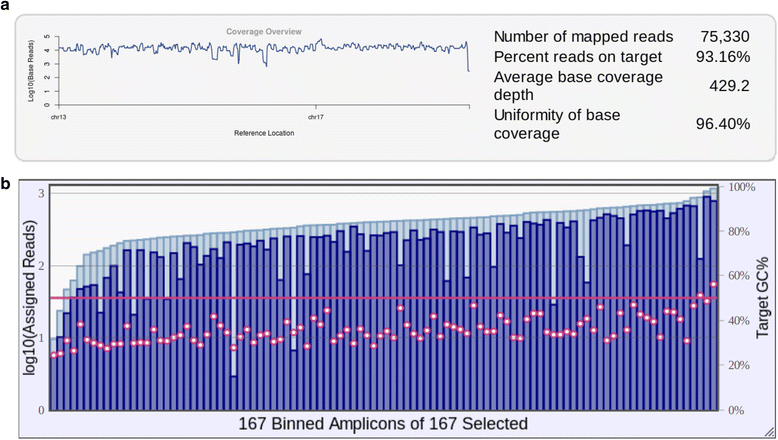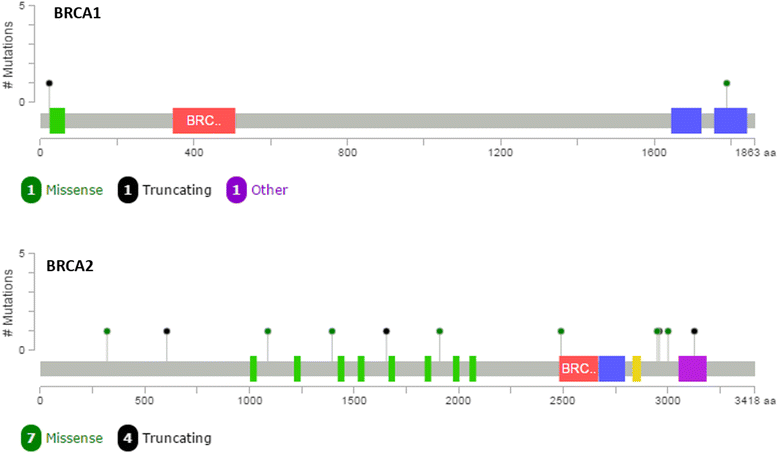Development and validation of a variant detection workflow for BRCA1 and BRCA2 genes and its clinical application based on the Ion Torrent technology
- PMID: 28651617
- PMCID: PMC5485501
- DOI: 10.1186/s40246-017-0110-x
Development and validation of a variant detection workflow for BRCA1 and BRCA2 genes and its clinical application based on the Ion Torrent technology
Abstract
Background: Breast cancer is the most common among women worldwide, and ovarian cancer is the most difficult gynecological tumor to diagnose and with the lowest chance of cure. Mutations in BRCA1 and BRCA2 genes increase the risk of ovarian cancer by 60% and breast cancer by up to 80% in women. Molecular tests allow a better orientation for patients carrying these mutations, affecting prophylaxis, treatment, and genetic counseling.
Results: Here, we evaluated the performance of a panel for BRCA1 and BRCA2, using the Ion Torrent PGM (Life Technologies) platform in a customized workflow and multiplex ligation-dependent probe amplification for detection of mutations, insertions, and deletions in these genes. We validated the panel with 26 samples previously analyzed by Myriad Genetics Laboratory, and our workflow showed 95.6% sensitivity and 100% agreement with Myriad reports, with 85% sensitivity on the positive control sample from NIST. We also screened 68 clinical samples and found 22 distinct mutations.
Conclusions: The selection of a robust methodology for sample preparation and sequencing, together with bioinformatics tools optimized for the data analysis, enabled the development of a very sensitive test with high reproducibility. We also highlight the need to explore the limitations of the NGS technique and the strategies to overcome them in a clinically confident manner.
Keywords: BRCA; Breast; Cancer; Ion Torrent; Ovarian.
Conflict of interest statement
Ethics approval and consent to participate
Not applicable.
Consent for publication
Not applicable.
Competing interests
The authors declare that they have no competing interests.
Publisher’s Note
Springer Nature remains neutral with regard to jurisdictional claims in published maps and institutional affiliations.
Figures



Similar articles
-
Evaluation of the Ion Torrent PGM sequencing workflow for the routine rapid detection of BRCA1 and BRCA2 germline mutations.Exp Mol Pathol. 2017 Apr;102(2):314-320. doi: 10.1016/j.yexmp.2017.03.001. Epub 2017 Mar 2. Exp Mol Pathol. 2017. PMID: 28263838
-
Next-Generation Sequencing-Based Detection of Germline Copy Number Variations in BRCA1/BRCA2: Validation of a One-Step Diagnostic Workflow.J Mol Diagn. 2017 Nov;19(6):809-816. doi: 10.1016/j.jmoldx.2017.07.003. Epub 2017 Aug 17. J Mol Diagn. 2017. PMID: 28822785
-
BRCA1-2 diagnostic workflow from next-generation sequencing technologies to variant identification and final report.Genes Chromosomes Cancer. 2016 Oct;55(10):803-13. doi: 10.1002/gcc.22383. Epub 2016 Jul 4. Genes Chromosomes Cancer. 2016. PMID: 27225819
-
Twenty Years of BRCA1 and BRCA2 Molecular Analysis at MMCI - Current Developments for the Classification of Variants.Klin Onkol. 2019 Summer;32(Supplementum2):51-71. doi: 10.14735/amko2019S51. Klin Onkol. 2019. PMID: 31409081 Review. English.
-
[Testing of mutations in BRCA1 and BRCA2 genes in tumor tissues - possibilities and limitations].Cesk Patol. 2016 Fall;52(4):210-214. Cesk Patol. 2016. PMID: 27869447 Review. Czech.
Cited by
-
Microarray analyses reveal genes related to progression and prognosis of esophageal squamous cell carcinoma.Oncotarget. 2017 Aug 12;8(45):78838-78850. doi: 10.18632/oncotarget.20232. eCollection 2017 Oct 3. Oncotarget. 2017. PMID: 29108269 Free PMC article.
-
Application of a High-Throughput Targeted Sequence AmpliSeq Procedure to Assess the Presence and Variants of Virulence Genes in Salmonella.Microorganisms. 2022 Feb 5;10(2):369. doi: 10.3390/microorganisms10020369. Microorganisms. 2022. PMID: 35208824 Free PMC article.
-
Correlation between the number of false positive variants and the quality of results using Ion Torrent PGM™ sequencing to screen BRCA genes.Biomedica. 2021 Dec 15;41(4):773-786. doi: 10.7705/biomedica.5663. Biomedica. 2021. PMID: 34936260 Free PMC article.
-
Prevalence of BRCA1 and BRCA2 gene mutations in Chinese patients with high-risk breast cancer.Mol Genet Genomic Med. 2019 Jun;7(6):e677. doi: 10.1002/mgg3.677. Epub 2019 Apr 9. Mol Genet Genomic Med. 2019. PMID: 30968603 Free PMC article.
-
Comprehensive analysis of serum tumor markers and BRCA1/2 germline mutations in Chinese ovarian cancer patients.Mol Genet Genomic Med. 2019 Jun;7(6):e672. doi: 10.1002/mgg3.672. Epub 2019 Apr 10. Mol Genet Genomic Med. 2019. PMID: 30972954 Free PMC article.
References
-
- Ferlay J, Soerjomataram I, Dikshit R, Eser S, Mahters C, Rebelo M, Parkin D M, Forman D, Bray F. Cancer incidence and mortality worldwide: sources, methods and major patterns in GLOBOCAN 2012. International Journal Of Cancer. 2014; doi:10.1002/ijc.29210. - PubMed
-
- Pal T, Permuth-Wey J, Betts J A, Krischer J P, Fiorica J, Arango H, LaPolla J, Hoffman M, Martino M A, Wakeley K, Wilbanks G, Nicosia S, Cantor A, Stuphen R. BRCA1 and BRCA2 mutations account for a large proportion of ovarian carcinoma cases. Cancer. 2005; doi:10.1002/cncr.21536. - PubMed
-
- NIH, BRCA1 and BRCA2: Cancer Risk and Genetic Testing. 2016. http://www.cancer.gov/about-cancer/causes-prevention/genetics/brca-fact-.... Accessed 04 Apr 2016.
-
- O’Donovan P J, Livingston D M. BRCA1 and BRCA2: breast/ovarian cancer susceptibility gene products and participants in DNA double-strand break repair. Carcinogenesis. 2010; doi:10.1093/carcin/bgq069. - PubMed
Publication types
MeSH terms
Substances
LinkOut - more resources
Full Text Sources
Other Literature Sources
Medical
Miscellaneous

